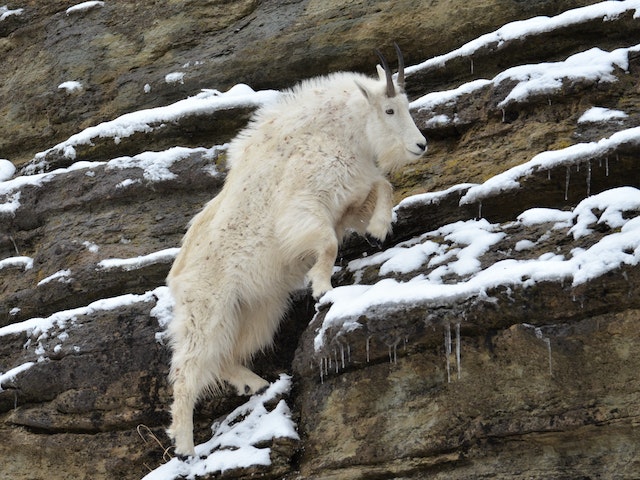
How do mountain goats climb cliffs? Through a combination of their hooves, muscles, and lack of fear.
Mountain goats can often be seen climbing cliff faces and even dams. There are two main reasons why they climb. The first is for food. They eat plants, grasses, and alpine vegetation, but they also lick the rocks they climb on for their salts and minerals. The second reason they climb is to avoid predators. There are no other land animals that can reach them when they perch on the side of a cliff. The only animal that can prey on mountain goats are eagles, and they do so by knocking or pulling the goats off and then eating them when they fall to the ground far below.
Mountain goats are found in the Rocky Mountains of North America. They reach as far north as Alaska and as far south as New Mexico. They have a thick woolen coat that helps them survive the bitter cold and is waterproof. In the winter, they grow an inner layer of hair which insulates them. They can survive temperatures as low as -50 °C and winds of 160 km/h. Despite being called mountain goats, they are not actually goats. Goats come from the capra animal family. Mountain goats belong to the Bovidae animal family, which contains animals such as bison, buffalo, and antelope.
Mountain goats have several adaptions that allow them to climb vertical cliffs. The first, and possibly most important, is the structure of their feet. Mountain goats have cloven hooves, which means that they are split into two halves. Each half of the hoof is like a finger, and they can spread very far apart. The hooves have a hard outer shell and a soft, rough pad underneath. The hard shell can dig into tiny cracks that human fingers would have trouble with and their ability to spread the toes out gives them excellent stability. The soft pad grips more efficiently than the best climbing shoes.
The second advantage they have is their shape. They look very large, and they can weigh up to 130 kg, but they are surprisingly narrow. They are built to press themselves in against a rock face while standing on a narrow ledge. Coupled with this they have a lower center of gravity than all other animals in their family.
The third advantage is their muscular legs and shoulders. When mountain goats climb they use their muscular shoulders to pull themselves up, but they have very muscular necks which also help. When they pull themselves up, they keep their elbows in close to their center of mass for balance and they pull with both their shoulder and neck muscles. This allows them to grip far in front of the point they would be able to if they were only using their shoulder muscles and it allows them to reach further. Keeping the elbows in close means that when they pull, they push themselves straight upwards without rotating outwards. Their strong leg muscles also allow them to make leaps of up to almost 4 meters.
The fourth advantage is their apparent lack of fear. Those of us who have tried to rock climb know how terrifying it can be, and this is part of the appeal of the sport. We would have to think twice before we made a leap across a rock face toward a tiny hold that we could barely see. Mountain goats don’t appear to have any such hangups and they make ridiculous leaps without a second thought. This has most likely been selectively bred for through evolution. Mountain goats live on cliffs to escape predators. Any animals that were too afraid to go onto the cliffs would have been eaten. Therefore, only the animals that were not afraid would have survived, and thus a fear of heights was bred out of them.
The last advantage appears to be their aggressiveness. Mountain goats often threaten or chase each other around the cliffs. They posture and, occasionally, even fight. Some goats get tossed off the cliffs, although, not many. This seems like it would be dangerous for animals that live perched on cliffs, but it turns out that it serves to keep the mountain goats in small communities, which makes more sense seeing as they live in an area that doesn’t have much space and has limited toe holds. Spreading out makes a lot of sense.
So, because of their hooves, strong neck and shoulder muscles, shape, lack of fear, and the fact that they spread out, mountain goats can climb cliffs easily. And this is what I learned today.
Sources
https://en.wikipedia.org/wiki/Mountain_goat
https://www.nationalgeographic.com/animals/mammals/facts/mountain-goat
http://thescienceexplorer.com/nature/how-mountain-goats-ascend-nearly-vertical-cliffs
https://www.sciencedirect.com/science/article/abs/pii/S0944200616300514
https://weather.com/photos/news/mountain-goats-how-do-they-do-it
https://www.nwf.org/Magazines/National-Wildlife/1997/King-of-the-Mountain
https://weather.com/photos/news/mountain-goats-how-do-they-do-it
